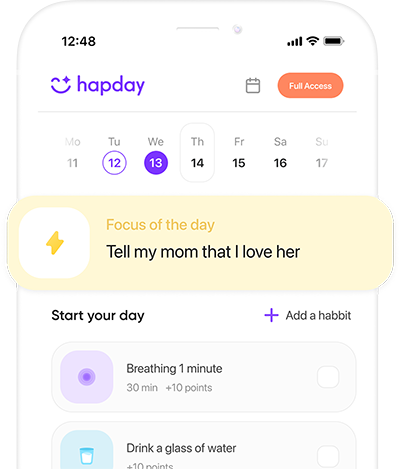Table of Contents
- Understanding Childhood Trauma
- What is Mindfulness Meditation?
- The Connection Between Mindfulness and Trauma
- How Mindfulness Meditation Helps Overcome Childhood Trauma
- Getting Started with Mindfulness Meditation
- Overcoming Challenges in Mindfulness Practice
- Integrating Mindfulness into Daily Life
- Conclusion
Understanding Childhood Trauma
Childhood trauma encompasses adverse experiences faced by a child, potentially affecting their mental and emotional health for a lifetime. A stark reality? Reports like the National Survey of Children’s Health note that nearly 34.8 million children in the U.S. have undergone at least one adverse childhood experience (ACE). And these range from physical, emotional abuse, neglect, or witnessing violence and substance issues at home.
Make no mistake—it’s a profound impact. Studies consistently point out that individuals with ACEs face greater risks of developing mental health disorders, health conditions, and even substance abuse later. Digging deeper into childhood trauma’s ripples provides a clearer map for pathways to healing—a beacon for those wishing to recapture their sense of self.
What is Mindfulness Meditation?
Mindfulness meditation. At its core? It’s about zeroing in on the now—anchoring your thoughts, feelings, and bodily sensations with acceptance. A practice deeply rooted in Buddhist tradition, it’s garnered appreciation across Western societies due to its therapeutic benefits. A pivotal study in “JAMA Internal Medicine” spotlights its efficacy: marked reductions in symptoms of anxiety, depression, and stress.
The Connection Between Mindfulness and Trauma
Here’s where mindfulness meditation uniquely shines in trauma recovery. It fosters awareness and acceptance. How does it work? By cultivating a non-judgmental awareness of thoughts and emotions, mindfulness aids individuals in processing traumatic memories without succumbing to them. For many with a history of trauma, this approach can dilute the sting of negative emotions and lessen PTSD symptoms.
Here’s something compelling—a University of Southern California study revealed mindfulness meditation strengthens the prefrontal cortex, responsible for emotion regulation. This alteration not only improves emotional balance but also tones down trauma symptoms.
How Mindfulness Meditation Helps Overcome Childhood Trauma
- Enhances Emotional Regulation: A primary boon of mindfulness meditation lies in its power to boost emotional regulation. It nudges individuals towards observing emotions with an accepting eye, fostering a better capacity to moderate emotional responses. Over time? Expect fewer emotional outbursts or depressive episodes, both frequent in trauma histories.
- Reduces Symptoms of Anxiety and Depression: Acknowledged for diminishing symptoms of anxiety and depression, mindfulness meditation becomes a beacon for those battling childhood trauma-linked conditions. A meta-analysis featured in “Clinical Psychology Review” affirmed mindfulness interventions effectively lower anxiety, depression, and stress across various groups. How? By rooting individuals in the present, breaking the loops of rumination and worry.
- Improves Self-Compassion and Self-Esteem: Trauma can weigh you down with self-blame and low self-esteem. Mindfulness meditation gently steers you towards self-compassion, promoting kindness over self-critique. Over time, expect an uplift in self-esteem and a healthier perspective on oneself—crucial for moving past negative self-images tied to trauma.
- Promotes Neuroplasticity: Neuroplasticity—ever heard of it? It’s the brain’s knack for reorganizing itself via new connections. Studies underscore that mindfulness meditation sparks neuroplasticity, delivering a healing touch to a trauma-battered brain. A Massachusetts General Hospital study noted that participants of an eight-week mindfulness program witnessed boosts in gray matter density, particularly in areas hit by trauma.
- Facilitates Acceptance and Letting Go: Through mindfulness meditation, individuals learn to accept their thoughts and feelings sans judgment. This acceptance acts as a soothing balm, allowing them to release past wounds and resentments. Embracing acceptance can diminish the emotional weight of traumatic memories, reducing their daily impact.
Getting Started with Mindfulness Meditation
- Setting Intentions: Kicking off a mindfulness practice? Start with intention. What drives you? Whether it’s calming anxiety, fostering self-awareness, or navigating trauma memories, clarity in intention guides your journey—keeping motivation alive.
- Creating a Safe Space: Especially significant for trauma survivors, crafting a nourishing meditation space is key. Opt for a tranquil and comforting nook. Spruce it up with elements that exude relaxation—soft lighting, calming tunes, or soothing scents can do wonders.
- Starting Small: New to mindfulness? Take it slow. Begin with brief sessions, say 5 to 10 minutes, then gradually extend as you ease into it. This approach averts overwhelm and builds a solid ongoing habit.
- Focusing on the Breath: Breath—that rhythmic anchor of mindfulness meditation. Tuning into your breath keeps you in the present, trimming distractions, and instilling calm. Observe each inhale and exhale’s subtle sensations, gently bringing attention back whenever your mind drifts.
- Practicing Guided Meditations: Guided meditations, particularly useful for beginners or those grappling with trauma, are guided by an instructor providing helpful cues. Resources abound—apps, online videos, podcasts—all tailored to varied needs.
Overcoming Challenges in Mindfulness Practice
- Dealing with Difficult Emotions: Expect tough emotions to surface during mindfulness, mainly for trauma survivors. Rather than sidestepping these feelings, approach them curiously and openly. Acknowledge their transient nature; they form an integral part of the healing journey.
- Managing Distractions: While unavoidable, distractions can be handled. When they occur, greet them without judgment, refocusing on your breath or anchor. With practice, distraction management becomes second nature, enhancing focus.
- Staying Consistent: Consistency—an ally in reaping the rewards of mindfulness. Carve out dedicated daily slots for meditation. Consider joining a meditation circle or syncing with a friend for additional support.
Integrating Mindfulness into Daily Life
- Mindful Eating: Mindful eating—paying attention to the sensory aspects of dining: taste, texture, aroma. This practice slows you down, turning meals into an immersive, pleasurable experience.
- Mindful Walking: A moving meditation of sorts, mindful walking hinges on being attuned to walking’s sensations. Focus on foot movements, ground contact, and breath rhythm, fostering both grounding and vitality.
- Mindful Listening: Mindful listening—engaging deeply with surrounding sounds. Be it music, nature, or a companion’s words, this practice boosts active listening, enriching interpersonal connections while honing presence.
Conclusion
Navigating childhood trauma remains a tough voyage. Yet, mindfulness meditation throws in a beacon of healing and resilience. By refining emotional regulation, soothing anxiety and depression, and kindling self-compassion, it aids in processing and relinquishing traumatic baggage. Weaving mindfulness into daily life nurtures a broader sense of well-being, paving the way for a promising future.
Embedding mindfulness meditation into life fosters substantial shifts in mental and emotional health. Eager to leap onto this healing path? Try the Hapday App for customized guided meditations and more.


This article really hits home! I’ve struggled with childhood trauma for years, and discovering mindfulness meditation has been a game changer for me. It’s amazing how just taking a moment to breathe can shift your entire perspective. I appreciate the emphasis on self-compassion too; it’s something I’ve been working on!
While I see the benefits of mindfulness meditation, I’m curious if it’s truly effective for everyone. Some people might need more than just breathing techniques to deal with deep-rooted trauma. Has anyone experienced this? Are there alternative therapies that complement mindfulness?
Wow, I had no idea about the neuroplasticity aspect! It’s incredible how our brains can change over time. Mindfulness seems like such a powerful tool for healing—definitely going to give it a shot after reading this article. Thanks for sharing!
I don’t mean to rain on the parade, but I’ve tried meditation before and found it quite challenging, especially when dealing with heavy emotions. Sometimes it feels more overwhelming than healing. Can anyone relate? How do you push through those tough moments?
‘Mindful eating’ sounds interesting! I never thought about how being present during meals could change my relationship with food. Maybe I’ll stop scrolling through my phone at dinner and actually taste my food instead. Anyone else tried this?
‘Facilitates Acceptance and Letting Go’ really resonates with me. Holding onto past traumas can be exhausting! Mindfulness meditation might just be what I need to start releasing those burdens one breath at a time.
‘Creating a Safe Space’ is such an important step in any mindfulness practice! I’ve set up my little nook at home that feels like a cozy retreat—definitely helps me focus better during meditation sessions.
‘Improves Self-Compassion and Self-Esteem’—this is something we all need! It’s so easy to fall into self-critique, especially after experiencing trauma. This article gives me hope that mindfulness could help shift that narrative.
‘Dealing with Difficult Emotions’ is so relevant! Emotions can really catch you off guard during meditation; it’s good to know it’s part of the process. Acknowledging them sounds like a healthy way to deal with them instead of pushing them aside.
‘Starting Small’ is great advice! It feels less daunting when you know you don’t have to dive into long sessions right away. Just focusing on my breath for five minutes sounds totally doable—thanks for the encouragement!
This article offers such a compassionate and insightful view on childhood trauma and mindfulness. I appreciate the emphasis on emotional regulation and self-compassion. It’s refreshing to see mental health being prioritized in this way. Mindfulness truly has the power to heal, and I hope more people discover its benefits through resources like this.
While the article provides some interesting points about mindfulness meditation, I can’t help but feel it oversimplifies the complexity of trauma recovery. Not everyone will find relief through meditation alone, and it’s misleading to present it as a one-size-fits-all solution. The nuances of individual experiences should be acknowledged more thoroughly.
I agree with you, SkepticalSam. It’s important to have diverse approaches in trauma recovery rather than relying solely on one method like mindfulness. There are many paths to healing, including therapy or medication.
True, but isn’t it worth exploring multiple avenues? Mindfulness might not work for everyone, yet it could complement other treatments effectively. Perhaps a broader perspective on integration would be beneficial.
This article is enlightening! The connection between mindfulness meditation and trauma recovery is fascinating. It’s amazing how simple practices can lead to profound changes in brain structure and emotional regulation. I’m eager to learn more about neuroplasticity and how I can incorporate these methods into my own life.
‘Mindfulness Meditation’? Really? Sounds like just another buzzword meant to capitalize on people’s struggles with mental health! Sure, it might help some folks, but let’s not pretend it’s the magic cure-all that will fix years of deep-seated trauma.
“Mindful eating” sounds great until you realize you’re just overthinking your lunch choices! Do I really need to ponder every flavor in my sandwich? Maybe I’ll just stick with mindless munching while binge-watching my favorite shows instead!
‘Mindful eating’ is too much pressure for me! Why can’t we just enjoy food without analyzing our feelings about each bite? Let’s be real; sometimes it’s just about devouring that pizza without judgment!
“The acceptance aspect of mindfulness caught my attention—it’s crucial for those battling inner turmoil from childhood experiences.” Understanding how acceptance aids healing resonates deeply with me; it’s a powerful step toward transforming pain into strength.
Absolutely! Acceptance can often feel like the hardest part of healing, yet it’s vital for growth. Kudos to the author for highlighting this essential aspect!
Acceptance isn’t just an endpoint; it’s an ongoing process we must revisit as we continue our journey through life.
The stats presented here are eye-opening regarding childhood trauma prevalence! It’s unsettling that so many children experience adverse experiences; our society must do better at supporting these individuals early on.
Another article touting mindfulness without considering its limitations—great! What happens when someone tries meditation and finds it doesn’t work? Are we going to tell them they’re not doing it right or that they need more practice? That’s quite discouraging!
I love how this article highlights various aspects of integrating mindfulness into daily life! Simple practices like mindful walking or eating can create a positive ripple effect in our well-being.
The promotion of neuroplasticity through mindfulness is indeed remarkable; however, let’s not forget that significant change often requires professional guidance beyond what self-directed practices can provide.